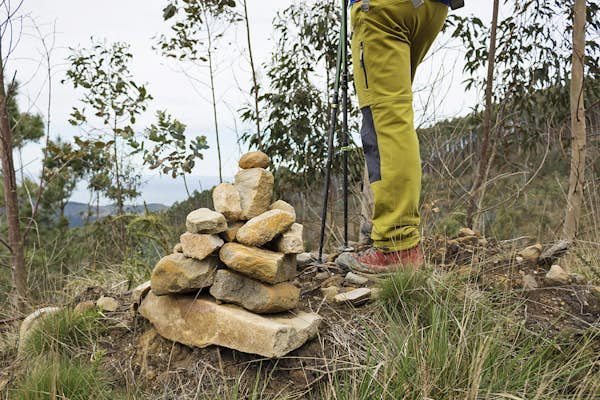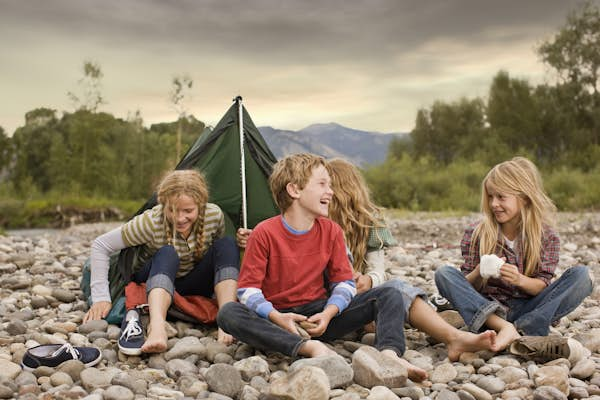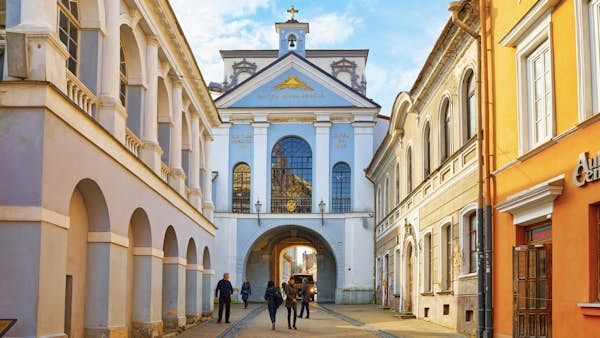


Please don’t stack rocks on your next hike. Here’s why.
Rock-stacking is one of humanity’s most ancient art forms. But it is also contentious.
Hike far enough on just about any trail in the world, and you’ll likely spot a collection of stones placed atop each other that form impromptu sculptures. Some call them cairns. Others favor more colorful terms like “stone balancing” or “prayer stone stacks.” Whatever the name, the act of stacking rocks atop each other is ubiquitous.
Over the past decade or so, for better or worse, rock-stacking has become even more popular. What many don’t know, though, is that the practice is controversial, particularly in national parks and other protected areas. Depending on who you ask, it can be a crucial navigational device, a rewarding mindfulness practice or an environmental menace.
So, is rock stacking as harmless as it seems? Let’s dig in.

Rock stacking: from tradition to trend
Cairns were our ancestors’ first foray into building structures – pile some rocks on top of each other, and they would have the beginnings of a shelter or a food cache, for example. In Mongolia, cairns marked burial sites in cemeteries. In Tibet, Buddhists used them in ceremonies to call in good fortune and balance out conflicting energies. Before the invention of lighthouses, cairns warned sailors away from Norway’s jagged fjords.
Rock stacks became landmarks on hilltops in Scotland and trade route markers for sled dogs plowing through the Alaskan wilderness. For a time, they were a key tool in a strategy for hunting bison, used by a variety of Indigenous communities from the Rocky Mountain foothills to deep in the Dakota plains.
Today, the popularity of rock cairns has less to do with utility and tradition and more to do with social media. At least that’s the opinion of the Colorado-based rock-stacking artist, Michael Grab, who goes by the moniker Gravity Glue.
“It really started to blow up between 2014 and 2015,” he said, speaking about the trend of stacking rocks in gravity-defying formations and then posting the photos onto social media. “Then it exploded into this international art form, and what was maybe a handful of practitioners became hundreds.” Others followed, stacking rocks on beaches, on hiking trails, and, much to the chagrin of conservationists, in places where visitors are specifically asked to “leave no trace.”

When a pile of rocks points the way home
Some stackers do it to mark a trail, especially in less frequently navigated backcountry, and a well-placed cairn can indeed save lives. For that reason, Michael Larson, a public information officer with the US National Park Service doesn’t recommend kicking them over when you come across them, despite what you see on TikTok or online hiking forums. He points to certain locations where cairns are part of official policy.
“Carlsbad Caverns National Park uses cairns for safety to assist visitors with finding trails in remote areas of the park’s backcountry,” he said. Along volcanic landscapes in the jagged terrain of Hawaiʻi Volcanoes National Park, where cairns are still known by their traditional name, ahu, they’re also sometimes set up by park rangers, particularly in the most remote sections.
So, before you start kicking cairns over, consider why they were set up in the first place. There’s a good chance a park ranger stacked the rocks for safety reasons.

The arguments against cairns
Besides potentially confusing lost hikers, critics say rock-stacking can be culturally insensitive to past and present residents of the area. They also point to the cumulative effects disruptions can have on ecosystems underfoot.
On mountain trails, critics have said that when even a few stacked rocks fall, it can trigger cascades that could hurt unsuspecting hikers below. Even when they’re arranged to be completely safe, many nature photographers and other lovers of the outdoors simply say they’re an eyesore, distracting from the untouched environment.

Read the rules
While the National Park Service at times employs rock-stacking as part of its route-marking system, in most parks, the agency prohibits people from adding their own cairns. Like carving initials into a tree, leaving trash at a campground or spray-painting your name on a boulder, rock-stacking in most (but not all) national parks is punishable under the same laws that protect these places against vandalism and littering.
To differentiate official markers from impromptu ones, the National Park Service recommends that visitors check with park rangers for information about the design and materials used in the creation of any cairns along trails.
“We always encourage visitors to have a plan to find their way in park wilderness,” said Jonathan Shafer, the public affairs specialist for Zion National Park. He also emphasized that cairns should never be your only navigation tool. “Especially in remote areas, it’s important to have wayfinding tools like maps and a compass or GPS to navigate.”

So, is rock stacking bad?
On its own, rock stacking isn’t always a harmful practice, though it can be. For many people, it can also be therapeutic or even an artistic outlet. In the most remote locations on Earth, cairns can literally save lives. Always follow local regulations and don’t do it in national parks or other protected lands.
If you do feel the urge to sit on the side of a trail or a riverbank and build something, when you’re done, be like Grab and follow a leave-no-trace policy.
“I take it down when I’m finished to close the loop,” he said, even when he’s built an improbably stacked rock tower.

Bozeman on a budget – 11 ways to save without skimping on experiences
By Montana standards, Bozeman is an expensive place for a vacation. As one of the main gateways to Yellowstone National Park, hotel rooms (in fact, all forms of accommodation) come at a premium, especially in summer.
That said, food and drink costs are still reasonable, and it’s perfectly possible to have a budget-friendly trip, especially if you’re road-tripping with your own car and don’t mind camping rather than staying in a hotel room. Stretch your dollars and cents further with the following money-saving tips.
Daily Costs
- Chain hotel room for two in March/July: from $80/200
- Bison burger: $18
- Craft beer: $5-6 a pint
- National Forest campsite: $20 for two vehicles and up to eight people
- Mountain bike rental: $40-50 per day
- Tax: No sales tax (hurray!), but local accommodation tax of 8%, and Big Sky resort tax of 3%
- Museum of the Rockies admission child/adult: $12/20
- Whitewater rafting trip: $80
Pack a camp chair and go car camping
Rates at Bozeman hotels hit their apex in summer, but this is also the perfect season for camping. Save some serious money by heading to a Forest Service campground in the mountains outside town. There are numerous sites in the Hyalite Canyon and Gallatin Valley, though the nearest, Langohr, is 12 miles (19km) from town. In-town campgrounds offer more facilities but are more expensive and aimed more at RVers than tent campers. Bear Canyon Campground is one good option not too far from downtown.

Visit in the offseason
You’ll save money on both airfares and accommodation if you visit Bozeman outside of the summer peak season (June to August). The spring months of April and May and the fall months of October and November offer great weather and some of the best hotel deals, and you’ll see fewer crowds.
Be flexible and score some cheap flights
If you are flying into Bozeman, check fares with budget airlines such as JetBlue, Southwest and Allegiant Air, especially if you can avoid checking in any hold luggage. Also check fares to the larger airport in Billings, two hours’ drive away – both flights and car rentals can sometimes be cheaper here.
Head into the backcountry
Unlike in neighboring Yellowstone National Park, there are no fees for backpackers camping in the backcountry of Custer Gallatin National Forest. Invest in a map, bear spray and some freeze-dried camp food and you’re good to go. Rules dictate that you must camp at least half a mile from a road; be sure to follow Leave No Trace guidelines.

Save money on bear spray
Bear spray is an essential investment if you are heading into the Montana wilderness, but a can in a fancy outdoor gear shop can run to $50. Costco in Bozeman often offers the best deal in town, with two cans for around $45 during the summer season.
Alternatively, you can rent bear spray at Big Boys Toys by the day, but you’ll have to pay the purchase cost for the canister if you use it. When flying home, remember that you can’t take bear spray on a plane.
Connect with your inner mountain man in a forest cabin
The wilderness cabins maintained by the Custer Gallatin National Forest authorities are still a great deal, despite recent price hikes. The huts are pretty basic, offering little more than a stove and bunk beds with mattresses where you can unroll your sleeping bag, and you’ll have to hike or ski in, but a group of four can score one of these rustic beauties for around $15 per head, and the natural setting is simply wonderful.
Grab a takeaway gourmet lunch
The Bozeman Co-op is a local community institution. It’s the best place to shop for local produce, bulk organic non-GMO ingredients and pre-cooked meals. It’s not the cheapest place in town for groceries, but it is cheaper than a restaurant, and the food is top-quality.
Take-out meals, deli sandwiches, rice bowls and an in-house bakery provide plenty of choice, and there are two branches – a downtown store and the bigger mothership on West Main. The community notice board is a great place to find information on wellness activities.
Drink at the source
Bozeman’s half-dozen microbrewery taprooms offer the town’s best-value beer. Most breweries offer specials, from cheap fills for your growler (take-out bottle) on a Thursday to weekly Pints With a Purpose, when $1 from the price of a beer goes to a local community organization. Just remember that, unlike bars, breweries in Montana are required to close at 8pm.

Shave off some of the cost of skiing near Bozeman
Skiing is an expensive hobby in Montana, but there are ways to drive down costs. For a start, the community-run Bridger Bowl ski area is a much cheaper place to ski than ritzy Big Sky; lift tickets can be a third of the price of Big Sky tickets. Ski mid-week and buy tickets online in advance for the cheapest rates.
If you definitely want to ski Big Sky, then you’ll get big discounts on lift passes at the beginning and end of the season, notably in December and April. Save more by renting your gear in town instead of close to the slopes.
Sniff out the best happy hour deals
Taking advantage of happy hours in bars, taprooms and restaurants will save you a couple of dollars on drinks prices, normally between 2pm and 6pm, and sometimes after 10pm. Even sophisticated spots like Plonk and Copper Whiskey Bar offer drink and food specials at these times. Check out current deals on the Montana Happy Hour website.
Have dinner at a gourmet food truck
Between April and September, you’ll find an impressive array of food trucks parked outside Bozeman’s breweries, along Main St and at special events in town. Trucks shift location, but you will normally find a couple parked outside Outlaw Brewery serving up gourmet crepes, tacos, burgers and loaded fries. Best of all, food trucks offer tastier, more imaginative and cheaper fare than most town restaurants.

12 things you can do only in Lithuania
Lithuania is the unsung star of the Baltics. With a wealth of baroque and art deco architecture, sobering relics of a Soviet past, a thriving, ever-evolving dining scene and ample natural attractions, the country delivers something for every traveler.
Its rich history goes back millennia – and in spite its ever-changing borders over the years, including by its forcible incorporation into the USSR, Lithuania has always managed to hold true to its language, culture and national character. Even today, traditional villages, where crops are still gathered by hand and artisans practice crafts honed over centuries, thrive alongside cosmopolitan cities. Lithuania’s dense forests attract numerous foragers, while the Baltic Sea draws sun worshippers to the amber-speckled coast.
The following advice from a veteran visitor will help you turn your trip to Lithuania into an unforgettable one.

1. Explore the bewitching Curonian Spit
Cloaked in pine forest and bumpy with giant sand dunes that have given it the nickname “Sahara of Lithuania,” the Curonian Spit – a sliver of land barely more than 1km (0.6 miles) across – juts out into the Baltic Sea. Its four fishing villages of Nida, Juodkrantė, Pervalka and Preila make for restful stays, with the cycling on trails between Nida and Juodkrantė a great way to take in the highlights. Don’t miss the giant Parnidis Dune or the state-of-the-art Mizgiris Amber Museum in Nida. Climb Vecekrugas Dune (67m / 220ft) en route to Preila, and Nagliu Dune near Pervalka for fantastic views of the so-called Dead Dunes, cooling off with refreshing dips in the Baltic Sea as you go. Finally, swing by Witches’ Hill in Juodkrantė to commune with wood carvings of devils, witches and other mythological figures along a woodland sculpture trail.
Practical tip: Rent a bicycle from one of several outlets in Nida or Juodkrantė. Local buses connecting the villages have bicycle racks. A wonderful alternative way to explore the spit is by walking the long-distance Baltic Coastal Trail, which spans its coastline.
2. Encounter traditional Lithuanian culture in Dzūkija National Park
Rural tradition runs strong through the very south of the country. In the villages amid Dzūkija’s woodlands, locals still harvest their crops with scythes, weave their own wool and linen, and practice elaborate wood carving and basket weaving. To delve into this traditional way of life, check in for a farm stay in Merkinė, Marcinkonys or other villages. Explore Dzūkija either by walking or cycling the designated hiking trails in the national park, and interacting with pottery masters along the 12km(7.5-mile)-long Secrets of the Black Clay trail that connects Merkinė to other villages that practice this ancient ceramic art.
Planning tip: Join locals in foraging for mushrooms between August and November, and attend the mushroom festival in Varėna in September.

3. Reflect atop the Hill of Crosses
A mesmerizing sight greets you 10km (6 miles) north of Šiauliai: a small hill covered in thousands of crosses of various styles and scales. Rosary beads adorn some; others are fine examples of ironwork, or carved wooden folk-art masterpieces, mingling with Lithuanian koplytstulpis (wooden sculptures of a figure topped with a little roof) and magnificent sculptures of the Sorrowful Christ (Rūpintojėlis). Crosses have been placed here since the 14th century – and began reappearing as symbols of hope and defiance in Soviet times, when planting a cross was an arrestable offense. Today, the devout come from all over Lithuania and beyond.
Planning tip: Come here early in the morning for some quiet contemplation, and take your time wandering past the rows of crosses and around the hill’s base, drinking in the details. You may spot a memorial to 9/11 victims, recent tributes to those killed by COVID, blue-and-yellow ribbons in memory of civilians who have perished in Russia’s war on Ukraine and a cross fashioned from bicycle gears.
4. Admire Kaunas’ art deco buildings
During its two-decade stint as the country’s capital (when Vilnius was captured by Poland), Lithuania’s second city embodied inter-war optimism – a mood captured through a wealth of well-preserved art deco buildings from the era. To fully appreciate Kaunas, first take in its cobbled Old Town and its medieval castle, before taking the tree-lined Laisvės alėja to New Town, with its museums and fabulous 20th-century architecture, such as the Resurrection Church (1933) and the still-functioning Romuva Cinema (1940). Immersive visits to the Art Deco Museum and the Amsterdam School Museum are unmissable highlights. During these intimate tours of apartments that still boast their original period furnishings, you’ll sip sparkling wine while listening to the life stories of their former owners.
Practical tip: Visits to the private Art Deco Museum and Amsterdam School of Architecture museums must be booked in advance – and are worth planning your entire visit to Kanaus around.

5. Enjoy a quintessential Lithuanian summer in Aukštaitija National Park
Cloaked with pine and spruce forest and dotted with dozens of lakes, Lithuania’s oldest protected area is where city dwellers head every summer. You can join them in hiking or pedaling along the myriad woodland trails, summiting Ladakalnis Hill (a sacred pagan site in centuries past), foraging for bilberries and wild strawberries, swimming wild in the lakes, and canoeing or paddle boarding. In addition to outdoor pleasures, you can explore the ethnographic heritage of the tiny villages, from the Ancient Beekeeping Museum near Stripeikiai to Ginučiai’s still-working 19th-century watermill.
Practical tip: The town of Ignalina has the biggest range of accommodation and dining, while Palūšė is the main water-sports center. LitWild offers active, tailor-made guided tours of the national park.
6. Taste Biržai’s farmhouse beer
Northern Lithuania has been the land of barley-malt beer for over 1000 years, with villagers brewing unpasteurized, unfiltered kaimiškas alus (village beer) using locally grown hops. During Soviet times, the farmhouse brewing tradition was all but wiped out – but is now happily seeing a resurgence, particularly in and around Biržai, where ale-makers have resurrected ancient recipes. Rinkuškiai Brewery offers walk-through tours of the brewing facilities, where you get to witness the process from malting, milling and mashing up through to fermentation and bottling. The visit also includes a tasting of six types of unfiltered beer, from the black ale and porter to the pale ale, plus the smoky house gira (kvass).
Planning tip: Try to find yourself in Biržai during the exuberant two-day fiesta in August, when all of the town’s breweries offer their wares on the street.

7. Tour Vilnius, the country’s capital
Trying to decide how to spend your time in Lithuania’s capital city is a conundrum. You can’t go wrong with a stroll through the marvelously intact Old Town, where locals actually live, and where cobbled streets are lined with exceptional baroque, Gothic and Renaissance buildings. Take in its centuries-old university, Cathedral Square with its leaning bell tower and the views from Gediminas Hill. Then check out the offbeat, renegade-artists’ “republic” of Užupis, admire contemporary art at MO Museum, peruse the sobering Holocaust Museum and the Museum of Occupations and Freedom Fights, and see the scene at Lukiškės 2.0, a former Soviet prison turned funky arts venue.
Detour: Take a day trip by bus or train to scenic Trakai, home of Lithuania’s most impressive castle, which sits on an island in Lake Galvė. Paddle around it in rented watercraft and sample kybinai (meat-filled pastries) – the signature dish of the local Karaite ethnic minority – at lakeside restaurants.
8. Take the healing waters in Druskininkai
The pine-fringed riverside spa town of Druskininkai has been famous since the 18th century for the allegedly healing properties of the salty mineral water gushing from its springs. You can drink this healing elixir at the Health Resort Druskininkai, soak in it at the Grand Spa Lietuva, Spa Vilnius and Mineral Spa Draugyste, or stay in one of the spa-hotels and partake in treatments ranging from mud baths and salt-room sessions to deep-tissue massage and oxygen therapy.
Detour: Commune with Lenin and Stalin statues and other salvaged communist monuments and memorabilia at Grūto Parkas, 8km (5 miles) east of Druskininkai.

9. Go bird watching in the Nemunas Delta
Where the Nemunas River spills into the Curonian Lagoon south of the port of Klaipėda, the land dissolves into a wetland delta that teems with birdlife: 270 out of the 294 bird species found in Lithuania, to be precise. The conditions here make bird watching almost absurdly easy. Storks stare down at you from their nests on top of electricity poles as you travel south to Ventės Cape, which extends far into the lagoon. Near the tip of the cape, stop by the Ventės Ragas Ornithological Station, a bird-ringing station on the path of a busy bird-migration route that stretches from the Arctic to East Africa, to see cranes, tits, finches, geese and other migratory birds passing overhead in early autumn and in spring.
Practical tip: Bring birding binoculars to spot great crested grebes and white-winged black terns paddling on the lagoon.
10. Descend into a nuclear bunker at Žemaitija National Park
Deep in the heart of the densely forested and lake-speckled Žemaitija National Park, the only Soviet nuclear missile base in the region once housed four medium-range ballistic SS-4 missiles, armed with two-megaton-power thermonuclear warheads – enough firepower to flatten all of Europe. Descend into one of the underground bunkers, explore the reconstructed headquarters of the bunker commander, interact with the multimedia displays – and marvel at how close the world came to nuclear Armageddon.
Practical tip/detour: To explore the rest of the national park, rent a bicycle in Plateliai, the region’s main town. While you’re there, swing by Plateliai Manor to check out an incredible collection of traditional Shrove Tuesday masks.

11. Party it up in Palanga
One of Lithuania’s most popular seaside resorts since Soviet times, Palanga is a pounding party spot in summer. While pedestrianized Basanavičiaus gatvė becomes abuzz with arcade machines, merry-go-rounds, electric cars, buskers and late-night bars playing thumping music, much of tree-lined Palanga is incredibly tranquil. Take the coastal path through pine forest, detouring to the beach for sunbathing and swimming. Another highlight is the Amber Museum in the vast Botanical Park, with over 15,000 examples of Baltic gold on show inside a neoclassical palace. Expect everything from ancient insects trapped in a golden tomb to striking, contemporary jewelry by present-day amber masters.

12. Visit a nuclear power station in Ignalina
If you’ve seen the 2019 HBO miniseries Chernobyl, then you’ll recognize parts of the Ignalina Nuclear Power Plant (INPP) in Visaginas. While it’s currently an epicenter of “nuclear tourism,” the plant has been decommissioned due to the similarity of its design to that of the ill-fated nuclear power station in Chernobyl in Ukraine, and its reactors are in the process of being dismantled. Complete the online application form weeks or months in advance to take an in-depth, 3-hour guided tour of the facility, including the turbine hall, the RBMK reactor hall and unit control room. You can also get an overview of the history of the plant and its challenges during an Information Center tour, complete with VR headset.
Detour: The LitWild team will bring you into a simulator INPP control room near Visaginas, where the plant staff used to receive training on how to handle emergencies.

Copy My Trip: a week of island hopping around the Azores
Lonely Planet editor AnneMarie McCarthy recently returned from a jam-packed week in the Azores, exploring four different islands in 7 days.
As the lucky destination editor in charge of Lonely Planet’s Portugal coverage, I can tell you one thing with absolute certainty: you all love the Azores. Week after week, I see how readers like you are reading up on these green islands, which all your well-traveled friends are raving about.
When I got an invite from Visit Azores, I quickly packed up my rain jacket and sunscreen to check it out the archipelago for myself. Over the course of a week I visited the islands of São Miguel, Pico, Faial and Terceira, traveling between them mainly by plane but also by ferry.
What was the most touristy thing you did?
The most touristy activity I did was also my favorite: a dolphin- and whale-watching tour that set out from from Ponta Delgada on São Miguel. I’ve never had much luck with wildlife spotting, but since the Azores is one of the best places in the world for spotting cetaceans, I was optimistic. Between April and early July is an optimal time to set off, since the whales are on their annual migration and there are more species in the surrounding water. During nearly 3 hours at sea, we saw dolphins, orcas, sperm whales and pilot whales. All the whales kept their distance – but the dolphins got up close, chasing each other in front of the boat.

There are a limited number of companies in Azores with a license for this activity, and they all operate under strict “rules of engagement” – such as never approaching the animals from the front, and keeping a reasonable distance (the more vessels in the area, the further away they all have to be). None of this affects your chances of seeing them, however. I went with Futurismo, which offers two to three trips a day. The team is so confident you will have a successful sighting that if you happen to be unlucky, you can take a subsequent tour for free.
What was the handiest thing you packed?
My rain jacket. Although the sun did shine a lot, showers would blow through with little warning. The weather forecast on the islands is often not reliable – and when you’re spending so much time outside on hikes, you will want to be prepared for all eventualities. A lightweight, waterproof jacket will mean you can hike for hours without fear.

Yet no matter how well prepared you are, never hike off-trail, since you run the risk of damaging delicate endemic vegetation. What’s more, wild camping is not allowed anywhere on the islands. You’ll always be close to somewhere official to stay.
What’s your favorite photo from the trip and where was it taken?
This shot was taken at the bottom of a dormant volcano, Algar do Carvão. There are only three places in the world you can go inside one of these: Indonesia, Iceland and here, in the center of Terceira island. While you have to pass through a short tunnel to reach the interior, being inside doesn’t feel claustrophobic, as you can look up to the sky above.

You can also explore further into the caves to take in their cathedral-like spaces, all formed from volcanic stone. For something truly unique, occasional concerts take place here.
Best tip for someone who wants to plan the same trip?
Concentrate on fewer islands, or come for longer! Since the Azores lie in the middle of the Atlantic Ocean, the temptation to island hop is strong, particularly in the summer, when travelers are less likely to be affected by poor weather and subsequent plane and ferry cancellations. I would recommend sticking with two islands that suit your travel style for each week you’re in the Azores. You could stretch this to three, depending on the size and proximity of the islands you fancy. (Pico is very small, for example, and is only an hour for Faial by ferry, making for a faster and more convenient trip than the plane.)

The Azores are all about the outdoors and good food – and every island has both in abundance. Almost everywhere you stay will be peaceful. Which is why you’ll get the most out of your visit here when you have time to relax and soak it all in.
Where did you stay? What was the vibe?
With a lot of island hopping came a lot of lovely hotels, all of which brought something different. In São Miguel, the nature-themed Senhora da Rosa was lovely, with an outdoor pool and rooms decor inspired by the local landscape. The on-site restaurant, Magma, provided a great last meal of my trip.
The rooms in Pico’s Aldeia da Fonte Hotel are in buildings made of volcanic rock – yet they somehow all reminded me of an American summer camp (at least, like I’ve seen on television). On the property is a sea walk, complete with a terrace to watch the waves and a ladder to get down into the cove to swim. It’s a great place to relax after a day of climbing Mt Pico.

Faial’s Hotel do Canal is right on the pier, making it perfect for exploring the bright, colorful murals left by sailors over the centuries. And it’s within view of the famous Peter Café Sport, where the lemon gin-and-tonic is never a bad idea.
Quinta da Nasce Água in Terceira is just a 10-minute walk from the historic center of Angra do Heroismo but feels like it’s in the countryside. The staff was incredibly welcoming here. (And, in fact, everywhere I stayed.)
Best thing you ate?
This one is too tough! I enjoyed incredible food all week, ranging from the very traditional to the inventive. This being Portugal, you can expect a meat-heavy menu – although I did have the best mushroom risotto of my life at Sensi Azores Hotel. It’s essential to try a cozido das Furnas, an array of meats arranged in a clay pot that gets buried, then cooked (and flavored) by the geothermal heat of volcanic activity. I watched the cozido pots getting collected from Furnas Lake – before tucking into mine at nearby institution Tony’s.

Other memorable meals were at Pico’s famous Cella Bar, where on a windy day I had wine, tapas and a view of Faial. Don’t leave Terceira without trying the island’s famous Dona Amélia, a sticky, spicy cake. (In fact, each island has its own signature pastry.) I’d also recommend Quinta do Martelo’s alcatra: a comfort stew cooked in a clay pot with wine, simmering long and slow until the meat practically melts.
Did I mention the food was good in the Azores?
AnneMarie McCarthy visited the Azores at the invitation of Visit Azores. Lonely Planet does not accept freebies for positive coverage.




